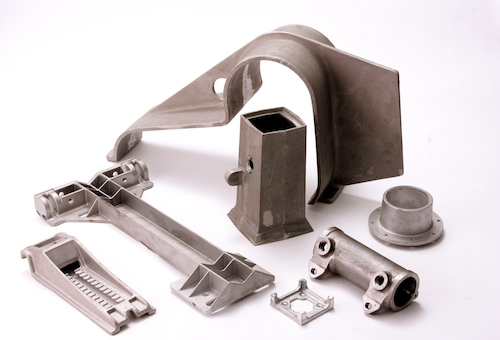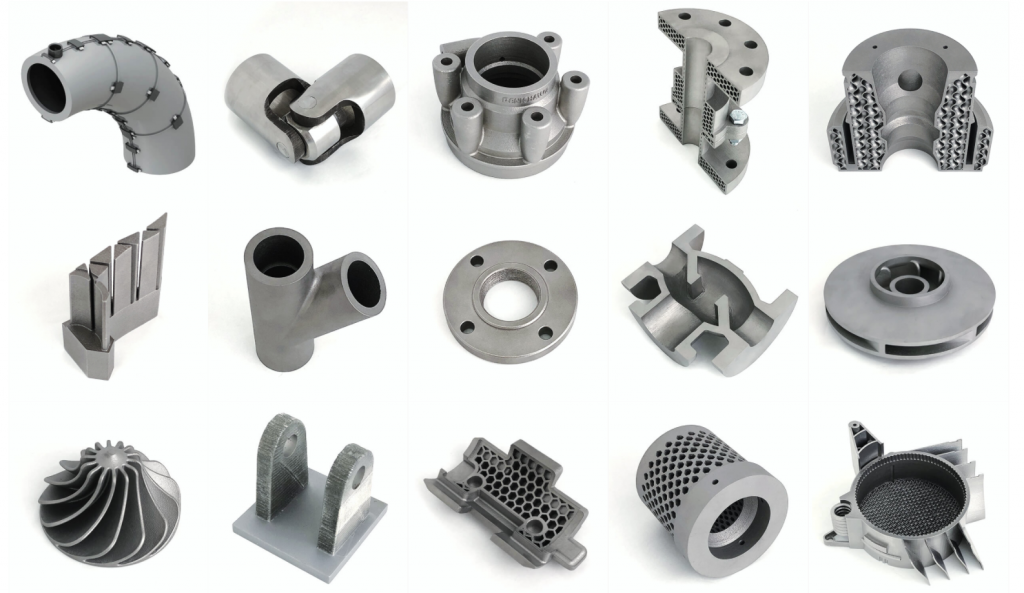Exploring the Versatile Makes Use Of and Applications of Light Weight Aluminum Castings in Modern Industries
Light weight aluminum spreadings have actually come to be indispensable to numerous contemporary markets because of their unique buildings. They use considerable advantages in weight decrease, thermal conductivity, and rust resistance. From automobile advancements to applications in durable goods and building and construction, their adaptability is amazing. The real extent of their influence prolongs beyond immediate benefits, hinting at more comprehensive ramifications for sustainability and efficiency. What exists in advance for aluminum castings in an ever-evolving industrial landscape?
Automotive Industry Innovations
The vehicle market has increasingly embraced light weight aluminum castings to boost vehicle efficiency and effectiveness. By making use of aluminum, suppliers can generate lighter parts, which add to boosted fuel economic situation and minimized exhausts. Key applications consist of engine blocks, transmission situations, and structural parts, where the material's strength-to-weight ratio provides toughness without including excess weight.
Light weight aluminum castings likewise use remarkable thermal conductivity, which aids in better heat dissipation, thus boosting engine performance. Innovations in casting innovations, such as die spreading and sand spreading, enable the manufacturing of complicated geometries, enabling for cutting-edge styles that optimize area and performance.
The recyclability of aluminum lines up with sustainability goals in the automotive market, advertising eco-friendly methods. As the market proceeds to introduce, making use of light weight aluminum castings is likely to increase, driving further innovations in lorry layout and efficiency.
Aerospace Innovations and applications
While the aerospace sector continues to focus on weight reduction and gas performance, aluminum castings have become an important material selection for different applications. Their lightweight nature, coupled with high strength-to-weight ratios, enables substantial enhancements in airplane efficiency and effectiveness. Light weight aluminum castings are generally made use of in architectural parts, such as fuselage frameworks and wing components, where decreasing weight is vital.
Recent developments in aluminum casting technologies, consisting of enhanced alloy formulations and accuracy spreading techniques, have additionally improved the material's performance abilities. These advancements enable the production of complex geometries and detailed designs while maintaining architectural honesty. Additionally, aluminum's outstanding corrosion resistance guarantees long life and reliability in extreme aerospace environments.
As the aerospace field increasingly embraces sustainability, aluminum spreadings provide a recyclable service that aligns with environment-friendly methods, making them an essential aspect in the growth of next-generation airplane.
Consumer Item and Everyday Products
As consumers increasingly look for lightweight yet durable products for daily items, light weight aluminum castings have acquired appeal in different durable goods. The special properties of light weight aluminum, including its resistance to rust and superb thermal conductivity, make it a perfect choice for things like pots and pans, house devices, and outdoor gear. For instance, aluminum cast pots and frying pans give even warm distribution, enhancing cooking effectiveness. Additionally, using aluminum in things such as bicycle frames and luggage assures an equilibrium in between stamina and portability. Producers value light weight aluminum castings for their versatility, as they can be quickly formed into intricate forms while keeping architectural stability. In addition, the ability to recycle light weight aluminum without deteriorating its homes lines up with growing consumer preferences for lasting items. Generally, light weight aluminum castings are essential to the production of long lasting, useful, and visually pleasing customer products, meeting the demands of modern way of livings.
Building and Architectural Makes Use Of
Light weight aluminum castings have actually become a vital part in construction and building style, specifically because of their strength and lightweight nature. These buildings make light weight aluminum a perfect selection for various applications, including architectural components, exteriors, and attractive functions - Wisconsin Aluminum Foundry. Architects and builders progressively utilize aluminum spreadings for home window structures, doors, and roof, boosting both capability and aesthetics. The material's resistance to corrosion additionally expands its lifespan, reducing maintenance prices and making certain sturdiness in diverse ecological conditions
Light weight aluminum can be conveniently formed right into complex layouts, enabling for cutting-edge building expressions. Its versatility promotes the production of custom-made items that fulfill certain layout needs, from ornate barriers to complicated supports. As sustainability becomes a concern, aluminum's recyclability adds to its charm in eco-friendly building practices. In general, aluminum spreadings are revolutionizing the construction market by supplying light-weight, sturdy, and aesthetically appealing solutions.
Electrical and Electronic Elements
Aluminum castings play a vital role in the manufacturing of lightweight electrical units, which improve transportability and performance in different applications. On top of that, their excellent thermal conductivity makes them ideal for heat sinks, making sure peak efficiency and longevity of electronic elements. Light weight aluminum's conductive residential or commercial properties contribute to its usage in different electrical conductors, emphasizing its value in modern-day technology.
Light-weight Electric Units
Lightweight electrical enclosures play a crucial duty in securing sensitive digital components from environmental elements and physical damages. Built from aluminum castings, these units are valued for their strength-to-weight ratio, making them perfect for numerous applications across sectors. Their lightweight nature aids in decreasing general system weight, which is crucial in mobile and mobile electronics. Moreover, aluminum's rust resistance boosts durability, prolonging the life expectancy of the encased parts. The capacity to mold and mildew light weight aluminum into complicated shapes enables customized designs, catering to specific requirements while making sure effective warmth dissipation. Furthermore, these enclosures can be quickly incorporated right into existing systems, supplying flexibility and flexibility in contemporary technological atmospheres. In general, lightweight aluminum enclosures considerably add to the performance of digital tools.
Warmth Sinks and Conductors
While several products are used in electronic parts, light weight aluminum castings stick out for their efficiency in heat administration as heat sinks and conductors. Their outstanding thermal conductivity enables efficient warm dissipation, which is vital in preventing the getting too hot of digital gadgets. Light weight aluminum's lightweight nature even more improves its suitability for applications where weight is a considerable element, such as in aerospace and vehicle industries. Additionally, light weight aluminum spreadings can be easily molded into intricate shapes, offering design flexibility for maximizing thermal performance. The deterioration resistance of aluminum likewise contributes to the longevity and integrity of these components in numerous settings. As modern technology read this breakthroughs and gadgets come to be a lot more compact, the demand for effective warmth administration solutions, like light weight aluminum castings, continues to grow.
Marine Sector Application
The aquatic industry significantly relies on light weight aluminum spreadings for their exceptional longevity and corrosion resistance. These residential properties make aluminum a perfect option for different applications, consisting of boat hulls, engine parts, and marine equipment. The lightweight nature of aluminum castings makes it possible for boosted gas efficiency and simpler ability to move in watercraft, which is necessary for both entertainment and business vessels.

Aluminum spreadings additionally provide considerable expense benefits because of their long life-span and low maintenance demands, reducing the overall functional costs for aquatic drivers. Furthermore, the convenience of light weight aluminum permits intricate designs that can meet specific efficiency demands.
Manufacturers in the marine sector utilize innovative casting methods to create intricate shapes, making certain that parts satisfy strenuous safety and efficiency criteria. As the need for high-performance marine vessels expands, light weight aluminum spreadings are placed as a crucial product in improving the functionality and long life of aquatic equipment.
Sustainability and Recycling in Light Weight Aluminum Casting

Aluminum Recycling Process
Reusing aluminum plays an important function in reducing environmental effect and saving resources within the spreading sector. The aluminum recycling process starts with the collection of scrap light weight aluminum, which can consist of old parts, manufacturing waste, and post-consumer products. This scrap is then sorted, cleaned, and shredded right into small pieces to assist in melting.
As soon as prepared, the aluminum scrap is melted in a heater at lower temperatures than main light weight aluminum production, considerably minimizing power consumption. The liquified aluminum is after that cast into ingots or various other forms for reuse in various applications - Wisconsin Aluminum Foundry. This closed-loop system permits the efficient recovery of light weight aluminum, protecting its buildings while minimizing the need for virgin materials. As a result, the reusing process is a vital element of sustainable techniques in aluminum spreading
Ecological Benefits
While aluminum casting plays a critical function in various sectors, its environmental advantages are specifically exceptional regarding sustainability and resource preservation. The lightweight nature of light weight aluminum adds to power performance in transportation, lowering fuel intake and exhausts. In addition, light weight aluminum casting helps with the use of recycled products, significantly reducing the energy required for manufacturing contrasted to primary light weight aluminum. you could try here This recycling procedure decreases waste and decreases the environmental influence connected with mining and refining resources. Light weight aluminum is 100% recyclable without deterioration of its residential or commercial properties, advertising a sustainable lifecycle. By selecting aluminum casting, markets can substantially reduce their carbon impact while advertising resource performance, making it an essential option in the quest of environmentally friendly production practices.
Closed-Loop Systems

Often Asked Questions
What Are the Key Perks of Light Weight Aluminum Castings Over Various Other Products?
Light weight aluminum spreadings offer lightweight properties, outstanding corrosion resistance, and high strength-to-weight ratios. They can be conveniently formed into complex shapes, provide good thermal and electrical link conductivity, and are affordable, making them more suitable over many different materials.
Just how Is the Light Weight Aluminum Casting Process Eco-friendly?
The aluminum casting procedure is eco-friendly because of its recyclability, reduced power consumption, and lowered waste production. Its capacity to make use of recycled materials decreases the carbon footprint, advertising sustainability within producing methods.
What Are Common Obstacles in Light Weight Aluminum Casting Manufacturing?
Usual obstacles in aluminum casting manufacturing consist of maintaining dimensional precision, managing thermal contraction, protecting against issues like porosity and inclusions, guaranteeing proper mold style, and optimizing manufacturing efficiency while reducing product waste and environmental influence.
How Do Light Weight Aluminum Castings Contrast in Cost With Other Manufacturing Techniques?
Aluminum castings commonly supply affordable prices compared to various other making techniques, particularly for tool to high-volume manufacturing. Their lower initial tooling expenses and efficient product use can lead to positive economics over time.
What Future Fads Are Anticipated in Aluminum Casting Innovation?
Future patterns in light weight aluminum casting technology are expected to consist of improvements in automation, enhanced alloy make-ups, improved recycling approaches, and the combination of 3D printing, all intended at enhancing efficiency, reducing expenses, and minimizing environmental effect.
Current advancements in aluminum spreading technologies, including enhanced alloy formulas and precision casting methods, have actually additionally enhanced the product's efficiency capabilities. Light weight aluminum spreadings have actually come to be an essential part in building and architectural layout, especially due to their stamina and light-weight nature. The aluminum recycling procedure starts with the collection of scrap light weight aluminum, which can include old elements, producing waste, and post-consumer items. As soon as prepared, the aluminum scrap is thawed in a heating system at reduced temperatures than key aluminum manufacturing, substantially decreasing power consumption. Additionally, aluminum casting assists in the use of recycled materials, significantly reducing the energy required for manufacturing contrasted to primary aluminum.